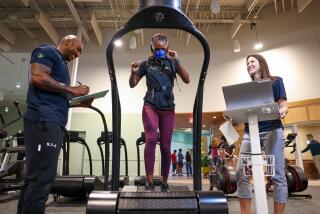Health clubs get in shape for an uphill climb to keep members
At the Bodies in Motion health club, Tee Mushonga wrapped up a successful sales pitch by handing a stack of paperwork to a new customer for the West Los Angeles facility.
If Mushonga, the club’s membership director, had looked through his office’s glass window, he would have seen another customer at the front desk completing paperwork.
This one wasn’t signing up for a new membership. He was canceling it.
“There’s definitely been an increase of cancellations,” said Mushonga, who estimated losing 155 members in December while bringing in 110 new ones.
For the workout business, 2009 is shaping up as a year in which health clubs will get worked over by the economy as members try to balance physical and fiscal health.
Though health club owners and industry officials expect a traditional surge in January as customers make New Year’s resolutions to get in shape, they’re aware of the financial crunch ahead.
“I anticipate the consumer will come out of this retail tailspin that happened over the last eight weeks and have to decide: ‘I only have so much money to spend. What will I spend it on?’ ” said Carl Liebert, chief executive of 24 Hour Fitness, based in San Ramon, Calif.
Fast turnover is typical in the business, with five out of 10 new members canceling in the first year, he said, but he’s unsure of 2009’s prospects.
Last month, Bally Total Fitness filed for bankruptcy protection under Chapter 11 for the second time in less than two years. In 2008, Bally closed 19 gyms nationwide.
The picture was better at 24 Hour Fitness, which added 19 clubs and brought in $1.4 billion in revenue -- a figure Liebert called a “single-digit increase.” But with his company benefiting from its sponsorship of the U.S. Olympic team, Liebert had expected to add 40 to 50 clubs. The credit crunch and mortgage crisis in September delayed those initiatives. For now, 24 Hour Fitness operates 415 locations in 15 states.
“Our year was like a basketball game where we were coasting with a 20-point lead but had to call a couple timeouts to win by two or three points,” Liebert said.
Still, the International Health, Racquet and Sportsclub Assn. contends that its industry is “recession proof” despite layoffs, the credit crunch and the mortgage crisis. The trade group has determined that consumers have spent consistent amounts of money on the health club industry despite economic uncertainties since 1981, the first year it tracked industry statistics.
Gym memberships peaked nationally in 2006 at more than 42 million and were down by less than 3% last year at 41.5 million, according to statistics provided by the health club group. In 2007, health clubs brought in $18.5 billion -- a $900,000 increase from 2006.
Association Chief Executive Joe Moore said the final numbers in 2008 would “probably” be the same.
“From talking to a lot of people in the industry, the bargain clubs and the high-end clubs continue to do well,” Moore said. “The clubs that are in that middle price range are having more trouble.”
Heading into 2009, health clubs are breaking a sweat to attract new members. Gold’s Gym, for instance, started the new year with free services, including four days of on-site workout advice from experts.
Mushonga said Bodies in Motion plans on doubling or tripling its marketing budgets in the company’s 10 locations in California, spending as much as $4,500 per club, up from about $1,500, in hopes of nabbing those trying to fulfill their New Year’s resolutions.
Promotions at Mushonga’s health club include a 15-month membership for the price of 12 months ($735) and 13-month memberships for the price of 10 ($490). Andrew Brook, the general manager of Equinox in Century City, said his club began providing free mini-massages and facials in December, resulting in two to three more appointments a day and bringing in an additional $600 to $700 a day.
Health club officials portray a membership as a necessity, not a luxury. But the customer reaction varied.
Ben Weiss, 31, of Century City has worked out at Bodies in Motion for two years and has tried persuading his brother, Brandon, to join after moving from the East Coast. Weiss said his brother figures he doesn’t need a gym to exercise. He can run outside in the warm climate.
“If I lost my job or something like that, the gym membership would probably be one of the first things I would cut back on,” said Weiss, a lawyer.
Bruce Namri, 25, of Calabasas pays $9 a month for a yearly membership at 24 Hour Fitness because his father’s insurance helps lower the payments.
“There’s no reason to quit,” said Namri, standing outside the 24 Hour Fitness on Fallbrook Avenue in Woodland Hills. That club normally charges members $30 a month. “It’s the closest one to where I live at this price range. I just go and use the basic weights. I don’t do anything fancy.”
Andy Hecht, 33, of Century City pays $220 a month for a membership at Equinox on Constellation Boulevard, which includes unlimited spa and Jacuzzi access.
“If I was paying $220 a month and not utilizing the facility, it would be counterproductive,” said Hecht, a producer for the NFL Network. “For me, I’m here six times a week. The value, convenience and luxury make it worth it.”
Hecht said he’d cut spending in other areas even if he lost his job. Brook thinks other customers agree, because the club saw a 30% increase in attendance in the last month.
“It’s a win for us because when someone gets results, they talk more about the club,” Brook said.
“We don’t want people to sign up and never come to us, because then they won’t talk about us.”
Health club owners hope to see more of that as customers try to shed the pounds from holiday gluttony and fulfill New Year’s resolutions.
“In L.A., people still want to look good and be healthy,” Mushonga said. “The last thing they want to compromise is their looks.”
--


